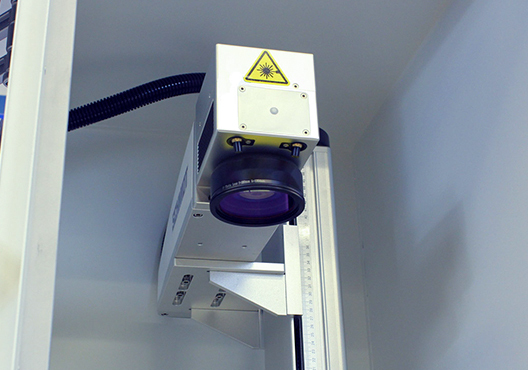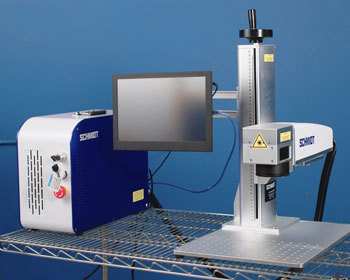Laser Sources
Different laser sources and types for flexible marking solutions
Open environment laser workstations are a great alternative when you have large parts that won't fit inside an enclosure, or if you simply want the freedom for different configurations.
GT SCHMIDT can help you determine the best laser for your application and build a marking solution using a selection of high-quality laser components to:
· Build an open environment laser lab
· Retrofit a current system or integrate into a current work cell
· Ensure sped up marking process and easy integration
· Allow for many different configurations and part sizes
Our open environment workstations are mountable onto a station or workstation, are available in fiber or diode laser sources, and can be a great option if an enclosure is not necessary.
Safety Tip: Laser components that are not inside a light-tight enclosure require special safety eyewear and restrictions since the laser is firing in an open environment. This type of laser setup is ideal for a private room or curtained space, where the laser and operator can work in isolation. If you require an enclosure, please see our complete laser marking systems.

GT SCHMIDT OFFERS FIBER, YVO4, AND CO2 LASER SOURCES
Fiber laser marking machines are solid-state diode pumped lasers that utilize fiber optics. They are the preferred technology for marking and engraving applications because they have the most application flexibility, the widest range of laser process capabilities, and can mark the largest variety of materials including all metals and some plastics.
Lasers are great marking solutions for many different applications but there isn't any one laser that can do it all. By offering four different laser types -- Infrared, Green, Ultraviolet, and MOPA -- in our GeoMARK and custom laser marking systems, we are able to provide solutions for a much wider range of applications.
Generally, these laser types have similar capabilities and characteristics. However, the specific qualities that distinguish one laser type from another can make it better for certain marking applications. Some lasers are more powerful and are better for engraving; some are faster and are best when short cycle times are required; some are capable of marking materials others cannot.
Our GeoMARK Eco is our standard, open-environment laser marking source. With its long z-axis of travel, touchscreen PC, and a 20-watt fiber laser, the GeoMARK Eco is ready for a variety of laser marking applications that are limited by an enclosed system. Due to its small, compact footprint, it can easily be integrated into your current work environment.
Visit our GeoMARK Eco page for more information.

WHAT ARE THE BENEFITS OF FIBER LASERS?
- Fiber lasers can mark all metals, many plastics, and some ceramics.
- They have high power output and excellent beam quality and pointing stability.
- Fiber lasers have long pulse widths which generates more energy for deep-engraving metals.
WHAT ARE SOME COMMON FIBER LASER APPLICATIONS?
- Fiber lasers can mark all metals including aluminum, steel, iron, and brass, as well as some plastics and ceramics.
- Fiber lasers are used in every industry and are commonly used to mark tracking and identification data on medical equipment, automobile parts, and much more.
WHAT FIBER LASER MACHINES DO YOU HAVE?
A 20-watt pulse fiber laser comes standard in our GeoMARK line of lasers, and the GeoMARK Pro can be upgraded to a 30-, 50-, or 100-watt laser. If you require a fiber laser system built specifically for your marking application, we can custom-build a laser specific to your application that incorporates feeders, custom software, enclosures, and more.
YVO4 laser marking systems are diode pumped solid state lasers that use a doped yttrium orthovanadate crystal as their gain medium. Instead of relying on a large energy source to generate a lot of power, these lasers produce a thin, concentrated beam that makes efficient use of energy to mark a wide variety of materials, including reflective surfaces. YVO4 lasers have short pulses, which makes it easier to mark sensitive materials without damaging it.
WHAT ARE THE BENEFITS OF YVO4 LASERS?
- YVO4 lasers are fast and powerful.
- They can create highly-detailed marks that are crisp, clear, and well-defined.
- YVO4 lasers are safer to use on sensitive materials.
- YVO4 lasers are particularly great for annealing and ablation.
WHAT ARE SOME COMMON YVO4 LASER APPLICATIONS?
- YVO4 lasers can mark on a wide variety of materials including all metals, many different plastics, ceramics, silcon, and even some gemstones.
- YVO4 lasers can be used to mark logos, identification marks, and more on many metal parts in every industry, but are especially useful for marking sensitive silicon and plastic parts like those found in electronics and medical equipment.
WHAT DIFFERENT TYPES OF YV04 LASERS DO YOU HAVE?
There are many different types of lasers available for marking. Each has qualities that make them ideal choices for specific applications. To provide marking solutions for a wide range of laser marking applications, we offer four different types of YVO4 lasers: Infrared, Green, Ultraviolet, and MOPA. To learn about these laser types, please visit our Laser Types page.
For more information on YVO4 lasers and help determining if they are the right laser for your marking application, give us a call at 847-647-7117.
Carbon Dioxide lasers use electricity to stimulate carbon dioxide and other gases to produce a laser. They operate at the 10,600 nm wavelength and are mostly used for marking applications on plastics and other non-metallic materials. These lasers are largely used in food, drug, and alcohol packaging; integrated circuits; electrical appliances; mobile communications; and electronic components.
WHAT ARE THE BENEFITS OF CO2 LASERS?
CO2 lasers are capable of marking many materials that other laser types cannot. They make efficient use of the power it generates, so they do not require a large power source. They have a very concentrated beam, which allows them to create clear marks with plenty of detail. This is particularly beneficial for marks that are small or have intricate designs.
WHAT ARE SOME COMMON CO2 LASER APPLICATIONS?
CO2 lasers can mark a wide variety of materials, including paper, cardboard, plastic, wood, leather, textiles, glass, and ceramics. Many of these cannot be marked by other laser types. These lasers are useful in any industry and are commonly used to mark packaging materials, clothing, and electronic parts.
CHOOSE FROM 4 DIFFERENT LASER TYPES
Infrared lasers operate at the 1064nm wavelength. This wavelength is outside the visible spectrum so we are not able to see the beam this laser produces. IR lasers are inexpensive and generate a strong laser beam despite not requiring a lot of power to produce it. They are great for producing a variety of marks and can mark all metals and even some plastics. They also make great contrast marks on coated metals. However, infrared lasers are unable to mark glass and other transparent surfaces.
Benefits of marking with an infrared laser:
- An inexpensive but powerful laser.
- Great for engraving, heat marks, etching, and ablation.
Infrared lasers can mark the following materials:
- All metals
- Some plastics
Green lasers operate at the 532nm wavelength. This wavelength is within the visible spectrum and the beam produced by this laser is green, hence the name. Marking with a green laser is often referred to as "cold marking" as it does not generate heat during the marking process. As such, it is ideal for materials that are heat sensitive, including reflective materials; delicate plastics; and soft or sensitive components.
The green laser’s beam is highly concentrated with an extremely small diameter. This creates accurate and detailed results great for small marks such as 2D data marks and ornate logos.
BENEFITS OF A GREEN LASER
- Can mark parts and materials other laser sources cannot.
- Can mark sensitive parts and materials.
- Marks a wide variety of parts and materials.
GREEN LASERS CAN MARK THESE KINDS OF MATERIALS
- Various kinds of plastics
- Cardboard
- Wood
- Reflective metals (e.g., silver and gold)
- Ceramics
Ultraviolet lasers (UV lasers) operate at 355nm. Despite generating little to no heat (i.e., cold marking), they can produce high-contrast marks on a variety of sensitive materials, including glass, ceramics, and plastics.
UV lasers can easily create marks without displacing or damaging materials which makes them popular in the medical and electronics industries where many applications require marking delicate materials and keeping parts sterile. Regardless of the industry though, UV lasers are great for any application that involves marking sensitive materials.
BENEFITS OF A UV LASER
- Creates high-contrast, easy-to-see, marks.
- Can mark a wide variety of sensitive materials.
- Can mark materials infrared lasers cannot.
- Marks without damaging/displacing material.
UV LASERS CAN MARK THE FOLLOWING MATERIALS
- Plastic
- Glass
- Silicone
The name "Master Oscillator Power Amplifier" comes from the two parts that are instrumental in producing the laser: the master oscillator which generates the laser beam and the power amplifier which strengthens and focuses the beam.
While other lasers have a fixed pulse duration, MOPA lasers have a variable pulse duration. Different pulse lengths contribute to a wider variety of marks on metals and plastics. MOPA lasers are very versatile, making them an ideal option for marking a wide variety of parts, from delicate plastics to stainless steel and other hard metals.
BENEFITS OF A MOPA LASER
- More control over the heat generated during the marking process.
- Capable of producing different color marks on some metals.
- More versatile plastic marking.
- Produce higher contrast marks on metals and plastic.
MOPA LASERS CAN MARK THE FOLLOWING MATERIALS
- All metals
- Some plastics
need a custom solution?
Our in-house design and engineering department has a full range of services and support to ensure that your industrial automation project is successful.
ADDITIONAL INFORMATION
Why GT SCHMIDT?
At GT SCHMIDT, we design, build, and implement marking solutions that help manufacturers leave a lasting mark on their products, their companies, and their industries.
Learn More About Us
made in usa since 1895

125 years of experience

installation & follow-up support



